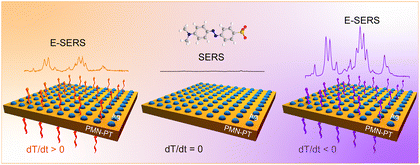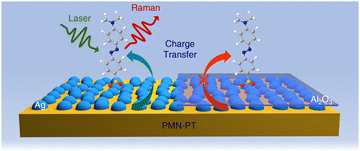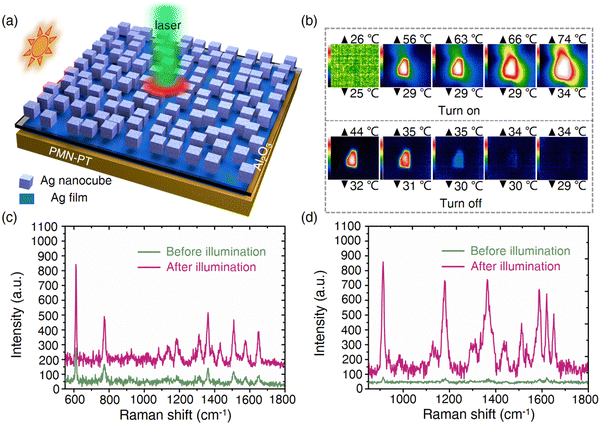Enhancing SERS activity with a pyroelectric-induced charge-transfer effect†
Xiaolu
Zhuo

School of Science Engineering, Guangdong Provincial Key Lab of Optoelectronic Materials and Chips, The Chinese University of Hong Kong, Shenzhen, Guangdong 518172, China. E-mail: zhuoxiaolu@cuhk.edu.cn
Abstract
This article highlights the recent work of Man, Pan, Li et al. (Nanoscale Horiz., 2023, https://doi.org/10.1039/D3NH00053B) on the significant SERS amplification achieved by a pyroelectric-effect-assisted platform by combining a pyroelectric material with plasmonic silver nanoparticles.
Surface-enhanced Raman scattering (SERS) is known to be driven by two mechanisms: electromagnetic enhancement (e.g., plasmon excitation) and chemical enhancement (e.g., charge transfer). Although numerous SERS substrates have been reported and commercialized, distinguishing between these two mechanisms and controlling their contributions in real time remains a significant challenge.1 The challenge arises from the difficulty of accurately estimating the contribution of charge transfer and the limited ability to adjust SERS enhancement once the substrate has been prepared.
Now, a team of Chinese researchers have developed pyroelectric-responsive SERS substrates by combining a pyroelectric material, Pb(Mg,Nb)O3–PbTiO3 (PMN-PT), with plasmonic silver nanoparticles (Ag NPs). Their strategy takes advantage of the pyroelectric effect, which converts temperature fluctuations into electricity, thus modifying the charge on the surface of the SERS substrates (Fig. 1). Heating the substrates (dT/dt > 0) generates a downward electric field on the substrate surface, whereas cooling them (dT/dt < 0) generates an upward electric field. In both cases, the SERS signals can be significantly amplified due to the piezoelectric-induced charge transfer between the LUMO level of the analyte molecule and the Fermi level of Ag. During the heating and cooling processes, the intensity of the SERS signals undergoes temporal changes, which can be modulated by adjusting the heating and cooling rate. Such chemical enhancement can further amplify SERS signals by over 100 times, compared to recordings obtained under steady-temperature conditions based solely on plasmon excitation.
 | ||
| Fig. 1 Schematic depiction of the SERS substrate based on PMN-PT and Ag NPs, illustrating the signal enhancement during heating (dT/dt > 0), steady temperature (dT/dt = 0), and cooling (dT/dt < 0). Reproduced from DOI: https://doi.org/10.1039/D3NH00053B with permission from the Royal Society of Chemistry. | ||
The researchers conducted systematic experimental characterization and theoretical calculations to understand the SERS performance of these substrates in a variable temperature environment. Different analytes were used to demonstrate the universal applicability of this method. Density functional theory calculations were performed for the Ag-NP molecular system to reveal the redistribution of charge density in response to an upward or downward electric field. In order to verify the role of chemical enhancement, the researchers used a thin layer of aluminium oxide (Al2O3) as a barrier layer to prevent charge transfer between the Ag NPs and the analytes (Fig. 2). Overall, although the electromagnetic enhancement was not optimized in this strategy, the researchers provided an in-depth understanding of the SERS mechanism and the role of charge transfer in chemical enhancement.
 | ||
| Fig. 2 Schematic illustration of the SERS experiment setup for understanding the SERS enhancement mechanism of PMN-PT/Ag NPs, by depositing a 5 nm Al2O3 layer to block the charge transfer between the Ag NPs and the analyte molecules. Reproduced from DOI: https://doi.org/10.1039/D3NH00053B with permission from the Royal Society of Chemistry. | ||
Furthermore, the researchers successfully demonstrated a nanocavity structure with PMN-PT/Ag/Al2O3/Ag-nanocubes (Ag NCs) (Fig. 3), which can be heated by simulated sunlight irradiation and achieve SERS enhancement, obviating the need for a temperature control platform. This development could have practical benefits for real-world applications.
 | ||
| Fig. 3 (a) The SERS measurement schematic diagram of a PMN-PT/Ag/Al2O3/Ag-NC substrate under simulated sunlight irradiation. (b) The temperature distribution images of PMN-PT/Ag/Al2O3/Ag-NCs after the simulated sunlight is turned on and off. The SERS spectra of rhodamine 6G (R6G) (10−7 M) (c) and crystal violet (CV) (10−7 M) (d) before and after simulated sunlight irradiation. Reproduced from DOI: https://doi.org/10.1039/D3NH00053B with permission from the Royal Society of Chemistry. | ||
In summary, the novel combination of PMN-PT and Ag NPs allows for a straightforward observation of chemical SERS enhancement and its active tuning, both of which are traditionally challenging in this field. These findings will facilitate a deeper understanding of the SERS mechanism and the development of other SERS substrates to improve the detection sensitivity.
Acknowledgements
X. Z. acknowledges funding from the Shenzhen Science and Technology Innovation Commission (JSGGKQTD20221101115701006).References
- J. Langer, D. Jimenez de Aberasturi, J. Aizpurua, R. A. Alvarez-Puebla, B. Auguié, J. J. Baumberg, G. C. Bazan, S. E. J. Bell, A. Boisen, A. G. Brolo, J. Choo, D. Cialla-May, V. Deckert, L. Fabris, K. Faulds, F. J. García de Abajo, R. Goodacre, D. Graham, A. J. Haes, C. L. Haynes, C. Huck, T. Itoh, M. Käll, J. Kneipp, N. A. Kotov, H. Kuang, E. C. Le Ru, H. K. Lee, J.-F. Li, X. Y. Ling, S. A. Maier, T. Mayerhöfer, M. Moskovits, K. Murakoshi, J.-M. Nam, S. Nie, Y. Ozaki, I. Pastoriza-Santos, J. Perez-Juste, J. Popp, A. Pucci, S. Reich, B. Ren, G. C. Schatz, T. Shegai, S. Schlücker, L.-L. Tay, K. G. Thomas, Z.-Q. Tian, R. P. Van Duyne, T. Vo-Dinh, Y. Wang, K. A. Willets, C. Xu, H. Xu, Y. Xu, Y. S. Yamamoto, B. Zhao and L. M. Liz-Marzán, ACS Nano, 2020, 14, 28–117 CrossRef CAS PubMed.
Footnote |
| † This content was originally published on our blogs platform at https://blogs.rsc.org/nh/2023/08/29/enhancing-sers-activity-with-a-pyroelectric-induced-charge-transfer-effect/ |
| This journal is © The Royal Society of Chemistry 2024 |

